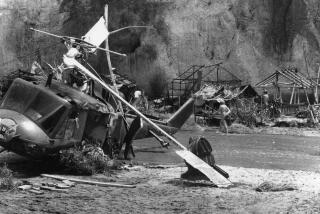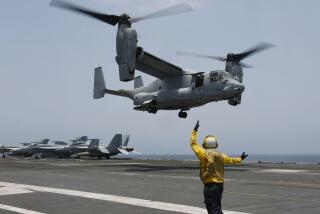Jury Begins Weighing Fate of Marine Pilot
- Share via
CAMP LEJEUNE, N.C. — A jury of eight Marine Corps officers Wednesday began deliberating the fate of Capt. Richard Ashby, a veteran pilot from Mission Viejo, Calif., who prosecutors insisted flew recklessly when he clipped a cable, plunging 20 skiers in an Italian gondola to their deaths last year.
“He was flying too fast and too aggressive. He was flying dangerously,” argued Maj. Daniel J. Daugherty, a Marine Corps prosecutor summing up the government’s evidence in a case that frayed U.S.-Italian relations and heightened controversy over the continued presence of American military personnel in Europe.
“Who was ultimately responsible?” Daugherty asked the jurors. “It was Capt. Ashby.”
But the 31-year-old pilot’s civilian attorney said that, although Ashby became disoriented over the northern Italian Alps, he should not be locked away in a military prison because of the few moments that he tried to miss the cable car wires that suddenly appeared in front of his EA-6B Prowler jet.
“This flight was not flown in an unsafe way,” said the lawyer, Frank Spinner. “And there are reasonable explanations for how he had only six to eight seconds before he hit that cable, for how that could have happened.
“Isn’t that what this case comes down to, ultimately?” Spinner asked the jury. “It comes down to a period of six to eight seconds.”
Charges Against Pilot Detailed
The jury deliberated four hours and is to return this morning to continue debating whether Ashby should be convicted on 20 counts of involuntary manslaughter, one count each of damaging the jet and destroying the gondola and a final charge of dereliction of duty. Votes of only six of the eight jurors are required to reach a verdict.
If convicted on all charges, Ashby could be sentenced to a maximum punishment of more than 200 years in the U.S. Disciplinary Barracks at Ft. Leavenworth, Kan.
The court-martial began a month ago under high security here, and relatives of the dead--Italians, Belgians, Germans, Poles, Austrians and Dutch--have taken turns coming to Camp Lejeune at U.S. expense to see for themselves whether this country’s Uniform Code of Military Justice will live up to its name.
It was on the afternoon of Feb. 3, 1998, that Ashby flew low into the Cavalese Valley, the roar of his two turbojet engines waking babies from their naps and prompting one woman to climb atop a table to see what the commotion was.
The whoosh was followed by the loud crash of the Italian gondola falling 370 feet as the jet banked up and away from what the Marines have since nicknamed “Mishap Valley.”
At the court-martial, the closing arguments took all morning, with Daugherty, dressed in uniform, occasionally standing at attention with his chest out and shoulders high before the jury of captains and higher-ranking officers.
“The only one to blame here is Capt. Ashby,” he said. “He is the one who was grossly negligent.”
In contrast, Spinner addressed the jurors in his dark suit, telling them of Ashby’s youth in Southern California and how the collision occurred on his last flight before he was promoted from the old Prowler radar-jamming planes to sleek F-18 fighters.
Evidence presented in the court-martial showed that Ashby and his three crew members were flying at altitudes 65% below their 1,000-foot restricted level when they hit the wires. The plane was flying at 621 mph, faster than the 517-mph restriction.
“They blew right over the center of town,” said Daugherty.
But Spinner and his team of military defense lawyers argued that there were instrument malfunctions in the cockpit, most critically the jet’s radar altimeter, which gave the flight crew a false reading.
Spinner also contended that the mishap occurred when Ashby was checking a map after veering off course on the routine training flight. And, he said, flight maps did not indicate that cable cars were located in the valley.
“Negligence is knowing the cable is there and flying as though it is not,” he said. “Negligence is buzzing the town for some cheap thrill.
“Negligence is not the normal flying of this mission.”
Daugherty disagreed. He said that Ashby was “flat-hatting”--military slang for flying low and fast. He suggested that, because this was Ashby’s last mission in a Prowler, he ignored safety and chose to have fun.
“He put himself into a situation he couldn’t get himself out of,” Daugherty said. “He’s on a rocket sled going right through there. Instead of going up, he goes right down. He banks left and he banks right.
“Those are actions he is responsible for.”
Daugherty rejected Ashby’s testimony on the witness stand last week that he was busy checking maps when he saw the cable wires.
“That’s his final excuse. It’s an excuse to try to get out of going to jail,” he told the jury.
The jet’s right wing sliced two of the wires. “It’s like blowing a stop sign in a two-ton truck and you hit a school bus,” said Daugherty.
But defense attorney Spinner maintained that it was “foolish” to suggest Ashby would risk his promotion to F-18s by flying recklessly on one final joy ride in a Prowler.
“He’s an outstanding pilot, a natural pilot, someone who would not intentionally violate Marine Corps rules,” Spinner said.
Original Videotape Was Never Found
No pilot, he said, would willfully ignore the rules of safety. “They want to live to fly another day,” he said. “Most pilots I know love to fly. And they love living too.”
But another of Ashby’s actions could hurt him as the jury deliberates.
The crew had brought Ashby’s private video camera aboard the flight and filmed portions of the trip before the collision. Although Ashby testified they did not record the collision, he later removed the videotape, inserted a blank tape in the camera and passed it off to a crew member. The original videotape has never been located.
Ashby admitted on the stand that he was “wrong” not to turn over the tape to authorities, and prosecutors suggested that he was trying to cover up his errors. Ashby also faces a charge of obstruction of justice.
“That’s not honesty. That’s not integrity,” Daugherty said of Ashby’s failure to turn over the tape. “It’s an absolute admission of guilt--plain, simple and clear.”
Spinner said the crew did not record the events leading up to the collision.
After the Ashby trial, his co-pilot, Capt. Joseph P. Schweitzer, 31, of Westbury, N.Y., is to be court-martialed on the same charges as Ashby.
One of Schweitzer’s lawyers, Navy Lt. Kathryn L. Clune, recalled Wednesday afternoon that Daugherty, in his closing arguments, referred to Schweitzer as an “experienced, exceptional navigator” and that “Capt. Schweitzer did not cause this accident.”
She urged military officials to dismiss the case against him.
The other two crew members--Capt. William L. Raney II, 27, of Englewood, Colo., and Capt. Chandler P. Seagraves, 29, of Nineveh, Ind.--were given immunity from prosecution and testified as government witnesses.
More to Read
Sign up for Essential California
The most important California stories and recommendations in your inbox every morning.
You may occasionally receive promotional content from the Los Angeles Times.














